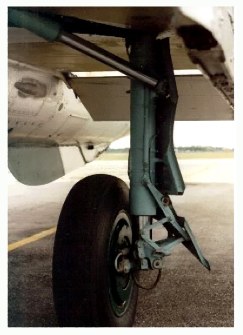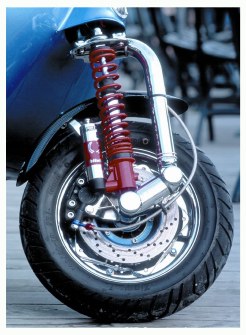
| Model Number: VSX1T INTRODUCED: 1977 - DISCONTINUED: 1982 Manufactured in: Genoa, Italy Style Variations: P150X, PX150E, PK125, PX125E, T5, T5- Classsic, PX200 The P200E was the Last of the true 'round-ish classic style Vespas. Later this Vespa was replaced by the VERY square PX200. Which is generally considered unattractive for it's pure 1980's cube-like styling.' The British and Euro P200 alters from the USA version. |
STOCK SPECS:
1977 - 1982
|
Casing mouth: 3 transfer ports
Induction: disc valve
Bore: 66.5 mm
Stroke: 57 mm |
Cubic capacity: 198 cc
Compression ratio: 9.8: 1
Bhp at rpm: 12 @ 5700
Con rod length:110mm
|
Piston compression height: 42.5mm
Piston type: domed
Small end diameter:16mm
Big end diameter:20mm
|
Flywheel side bearing: ....
Drive side bearing: 613912
Input shaft bearing:6302
Output shaft bearing (flywheel side):
Rear wheel bearing:6204C4 |
Flywheel side oil seal: 24x35x6
Drive side oil seal: 31x62x4.3/5.8
Rear hub oil seal: 30x47x6
|
Top Speed: 120Kmh/75Mph |
PIAGGIO HISTORY: Vespa's timeless design comes from an equally timeless company Piaggio was founded in Genoa, Italy in 1884 by twenty-year-old Rinaldo Piaggio. Rinaldo's business began with luxury ship fitting. But by the end of the century, Piaggio was also producing rail carriages, luxury coaches, truck bodies, engines, and trains. With the onset of World War I, the company forged new ground with the production of airplanes and seaplanes. In 1917 Piaggio bought a new plant in Pisa, and four years later it took over a small plant in Pontedera in the Tuscany region of Italy. It was this plant in Pontedera which became its new center for aeronautical production (propellers, engines and complete aircraft). During World War II, the Pontedera plant built the state-of-the-art P 108 four-engine aircraft, in both passenger and bomber versions. However, the plant was completely destroyed by Allied bombers due to its military importance. Piaggio came out of the conflict with its Pontedera plant in complete ruin. Enrico Piaggio was at the helm, having taken over from his father Rinaldo. Concerned about the disastrous state of the roads and the Italian economy, Enrico decided to focus the Company's attention on the personal mobility needs of the Italian people. Enter Corradino D'Ascanio, Piaggio's ingenious aeronautical engineer who designed, constructed and flew the first modern helicopter. D'Ascanio set out to design a simple, sturdy, and economical vehicle that was also comfortable and elegant. |


D'Ascanio, who could not stand motorcycles, dreamed up a revolutionary new vehicle. Drawing from the latest aeronautical technology, he imagined a vehicle built on a "monocoque" (French for "single shell") or unibody steel chassis. Furthermore, the front fork, like a plane's landing gear, allowed for easy wheel changing. The result was an aircraft-inspired design that to this day remains forward-thinking and unique among all other two-wheeled vehicles. Upon seeing the vehicle, Enrico Piaggio remarked "Sembra una Vespa!" This was a real two-wheeled utility vehicle. But it did not resemble an uncomfortable and noisy motorcycle. The steel frame's shape protected the rider from road dirt and debris. It emanated class and elegance at first glance. By the end of 1949, 35,000 units had been produced. Italy was getting over its war wounds and getting about on Vespas. In ten years, one million were produced. By the mid-fifties, Vespa was being produced in Germany, Great Britain, France, Belgium, Spain and, of course, Italy. |
The Genoa Italy Factory

ABOUT THE P SERIES |




